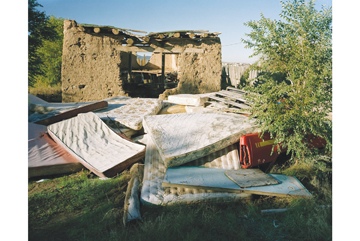
At 11:45 a.m. Wednesday Debora Hunter, an associate professor of art at SMU, sits in the Pollock Gallery in Hughes-Trigg. The gallery is empty. The chairs have just been set up into two neat rows.
Debora sits in her chair, which is placed in front of the two rows and slightly higher up than the rest. She looks over her notes and briefly discusses the things she will be going over during the lecture with her introducer.
At 11:50 a.m. people start trickling in and it becomes clear that more chairs will be needed.
The artist introduction is done promptly at noon, by which point a couple more chairs are added to the small room.
Standing patiently in the corner of the gallery dressed in a simple, all-black ensemble, Debora Hunter is ready to begin the lecture on her esteemed Consumer (Interests): Photographs from Taos, New Mexico exhibit.
She began by explaining the significance of place. “Place is like a partner in your life,” she said. Hunter went on to talk about Taos as a place, giving a little background on its geography and how many of its landscape views are similar to a
“cinematic experience.”
She has been photographing Taos for 10 years now, if anyone can tell you something about the physicality and culture of Taos, it’s Debora Hunter.
With Consumer (Interests) Hunter aims to explore the idea of man versus nature, and how our consumer culture is slowly posing a threat to Taos’ natural resources.
“I’m making pictures for myself and for you, but I’m also making pictures for history,” Hunter said.
She spoke of the need to document the change that is taking place in Taos, mainly the need to recognize the importance of nature.
“It reminds you that there is something else beyond where you are,” Hunter said, pointing out that Dallas seems to be missing that presence of nature due to the fact that almost everything is manmade.
Among the things she photographs are abandoned gas stations, self-storage rental units that stick out against the nature that surrounds them, old foreclosed suburban style houses and gardens affected by drought.
Her images are powerful and bright. They are divided into different sections: Accretion, Filling, Redaction and Praxis. Some are even positioned upside down, creating interesting shapes when placed directly next to each other.
“I liked her explanation of the pictures and why she grouped them,” Carla Mendiola, an SMU graduate student studying history, said.
“It makes no difference that its upside down,” Hunter said, smiling at her little act of rebellion. “I wanted to stop people.”
The exhibit is free and will be on display in the Pollock Gallery until Oct. 12.









